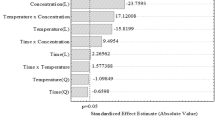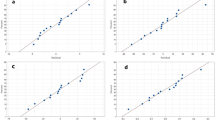Abstract
This study aimed to recover bioactive compounds by solid-liquid extraction from the agro-industrial residue obtained during juçara fruits processing into pulp. A preliminary study using different solvents (methanol, ethanol and water) indicated ethanol in aqueous solution as the best solvent for antioxidants recovery. Then, a Box-Behnken design was applied considering as independent variables the solvent composition (30–70% ethanol in water), temperature (30–70 °C) and time (30–60 min), in order to evaluate the effects of these factors on antioxidant activity in juçara extract. Results showed that the extracts with higher antioxidant activity were obtained using 30% ethanol at 70 °C for 60 min; measurements included ABTS and DPPH assays, determination of total phenolic content and total monomeric anthocyanins. Furthermore, the effect of pH in antioxidants recovery was evaluated. For this purpose, the 30% ethanol solution was acidified to pH 1 and 2 with HCl. Principal component analysis showed the formation of three distinct groups: one characterized by high bioactive compounds content (pH 1.0), another with superior antioxidant activity (pH 5.75, non-acidified), and finally the group at pH 2 presenting the worst concentrations in the evaluated responses. HPLC analysis showed the presence of cyanidin-3-O-rutinoside and cyanidin-3-O-glucoside in the extracts. Therefore, the conventional solid-liquid extraction using renewable solvent can be successfully applied to recover bioactive compounds from juçara residue, which can be used by different food industries.
Similar content being viewed by others
Abbreviations
- ABTS:
-
2,2′-azino-bis-[3-ethylbenzothiazoline-6-sulphonic acid] diammonium salt
- C3OG:
-
Cyanidin-3-O-glucoside
- C3OR:
-
Cyanidin-3-O-rutinoside
- DPPH:
-
2,2-Diphenyl-1-picrylhydrazyl
- GAE:
-
Gallic acid equivalents
- HPLC:
-
High performance liquid chromatography
- PCA:
-
Principal component analysis
- TE:
-
Trolox equivalent
- TMA:
-
Total monomeric anthocyanins
- TPC:
-
Total phenolic compounds
- RCF:
-
Relative centrifugal force
References
Bourscheid K, Siminski A, Fantini AC (2011) Euterpe edulis – Palmito juçara. In: Coradin L, Siminski A, Reis A (eds) Espécies nativas da flora brasileira de valor econômico atual ou potencial: plantas para o futuro - Região Sul, 2nd edn. MMA, Brasília, pp 178–183
Cardoso AL, Di Pietro PF, Vieira FGK et al (2015) Acute consumption of juçara juice (Euterpe edulis) and antioxidant activity in healthy individuals. J Funct Foods 17:152–162. https://doi.org/10.1016/j.jff.2015.05.014
Rufino M d SM, Alves RE, de Brito ES et al (2010) Bioactive compounds and antioxidant capacities of 18 non-traditional tropical fruits from Brazil. Food Chem 121:996–1002. https://doi.org/10.1016/j.foodchem.2010.01.037
Kuskoski EM, Asuero AG, Morales MT, Fett R (2006) Wild fruits and pulps of frozen fruits: antioxidant activity, polyphenols and anthocyanins. Ciência Rural 36:1283–1287
Borges GDSC, Gonzaga LV, Jardini FA et al (2013) Protective effect of Euterpe edulis M. on Vero cell culture and antioxidant evaluation based on phenolic composition using HPLC − ESI-MS/MS. Food Res Int 51:363–369. https://doi.org/10.1016/j.foodres.2012.12.035
Garcia-Mendoza MP, Espinosa-Pardo FA, Baseggio AM et al (2017) Extraction of phenolic compounds and anthocyanins from juçara (Euterpe edulis Mart.) residues using pressurized liquids and supercritical fluids. J Supercrit Fluids 119:9–16. https://doi.org/10.1016/j.supflu.2016.08.014
AOAC (2010) Official Methods of Analysis of the Association of Official Analytical Chemists, 18th edn. AOAC, Gaithersburg
Singleton VL, Rossi JA (1965) Colorimetry of total phenolics with phosphomolybdic-phosphotungstic acid reagents. Am J Enol Vitic 16:144
Georgé S, Brat P, Alter P, Amiot MJ (2005) Rapid determination of polyphenols and vitamin C in plant-derived products. J Agric Food Chem 53:1370–1373
Giusti MM, Wrolstad RE (2001) Characterization and measurement of anthocyanins by UV–visible spectroscopy. In: Wrolstad RE, Acree TE, An H, Decker EA et al (eds) Current Protocols in Food Analytical Chemistry, 1st edn. John Wiley & Sons, New York, pp F.1.2.1–F1.2.13. https://doi.org/10.1002/0471142913.faf0102s00
Gião MS, González-Sanjosé ML, Rivero-Pérez MD et al (2007) Infusions of Portuguese medicinal plants: dependence of final antioxidant capacity and phenol content on extraction features. J Sci Food Agric 87:2638–2647. https://doi.org/10.1002/jsfa.3023
Hidalgo M, Sánchez-Moreno C, De Pascual-Teresa S (2010) Flavonoid – flavonoid interaction and its effect on their antioxidant activity. Food Chem 121:691–696. https://doi.org/10.1016/j.foodchem.2009.12.097
Gouvea ACMS, Melo A, Santiago MCPA et al (2015) Identification and quantification of anthocyanins in fruits from Neomitranthes obscura (DC.) N. Silveira an endemic specie from Brazil by comparison of chromatographic methodologies. Food Chem 185:277–283. https://doi.org/10.1016/j.foodchem.2015.02.086
Bicudo MOP, Ribani RH, Beta T (2014) Anthocyanins, phenolic acids and antioxidant properties of Juçara fruits (Euterpe edulis M.) along the on-tree ripening process. Plant Foods Hum Nutr 69:142–147. https://doi.org/10.1007/s11130-014-0406-0
Paes J, Dotta R, Barbero GF, Martínez J (2014) Extraction of phenolic compounds and anthocyanins from blueberry (Vaccinium myrtillus L.) residues using supercritical CO2 and pressurized liquids. J Supercrit Fluids 95:8–16. https://doi.org/10.1016/j.supflu.2014.07.025
Nijveldt R (2001) Flavonoids: a review of probable mechanism of action and potential applications. Am J Clin Nutr 74:418–425
Norberto S, Silva S, Meireles M et al (2013) Blueberry anthocyanins in health promotion: a metabolic overview. J Funct Foods 5:1518–1528. https://doi.org/10.1016/j.jff.2013.08.015
Urias-Lugo DA, Heredia JB, Muy-Rangel MD et al (2015) Anthocyanins and phenolic acids of hybrid and native blue maize (Zea mays L.) extracts and their antiproliferative activity in mammary (MCF7), liver (HepG2), colon (Caco2 and HT29) and prostate (PC3) cancer cells. Plant Foods Hum Nutr 70:193–199. https://doi.org/10.1007/s11130-015-0479-4
Ballesteros LF, Teixeira JA, Mussatto SI (2014) Selection of the solvent and extraction conditions for maximum recovery of antioxidant phenolic compounds from coffee silverskin. Food Bioprocess Technol 7:1322–1332. https://doi.org/10.1007/s11947-013-1115-7
Ignat I, Volf I, Popa VI (2011) A critical review of methods for characterisation of polyphenolic compounds in fruits and vegetables. Food Chem 126:1821–1835. https://doi.org/10.1016/j.foodchem.2010.12.026
Naczk M, Shahidi F (2004) Extraction and analysis of phenolics in food. J Chromatogr A 1054:95–111. https://doi.org/10.1016/j.chroma.2004.08.059
Inada KOP, Oliveira AA, Revorêdo TB et al (2015) Screening of the chemical composition and occurring antioxidants in jabuticaba (Myrciaria jaboticaba) and jussara (Euterpe edulis) fruits and their fractions. J Funct Foods 17:422–433. https://doi.org/10.1016/j.jff.2015.06.002
Borges GDSC, Vieira FGK, Copetti C et al (2011) Optimization of the extraction of flavanols and anthocyanins from the fruit pulp of Euterpe edulis using the response surface methodology. Food Res Int 44:708–715. https://doi.org/10.1016/j.foodres.2010.12.025
Rodrigues S, Fernandes FAN, de Brito ES et al (2015) Ultrasound extraction of phenolics and anthocyanins from jabuticaba peel. Ind Crop Prod 69:400–407. https://doi.org/10.1016/j.indcrop.2015.02.059
Castañeda-Ovando A, de Lourdes P-HM, Páez-Hernández ME et al (2009) Chemical studies of anthocyanins: a review. Food Chem 113:859–871. https://doi.org/10.1016/j.foodchem.2008.09.001
Acknowledgments
The authors gratefully acknowledge the institutions: Coordenação de Aperfeiçoamento Pessoal de Ensino Superior (CAPES), Universidade Federal do Rio de Janeiro, Embrapa Agroindústria de Alimentos and University of Minho by the financial support of the research work and Juçaí Alimentos for the juçara residue. Ricardo N. Pereira gratefully acknowledge to Portuguese Foundation for Science and Technology (FCT) the financial grant with reference SFRH/BPD/81887/2011.
Author information
Authors and Affiliations
Corresponding author
Ethics declarations
Conflict of Interest
The authors declare that they have no conflict of interest.
Human and Animal Rights
This article does not contain any studies with human or animal subjects.
Electronic supplementary material
ESM 1
(PDF 438 kb)
Rights and permissions
About this article
Cite this article
Ribeiro, L.O., Pereira, R.N., Tonon, R.V. et al. Antioxidant Compounds Recovery from Juçara Residue by Thermal Assisted Extraction. Plant Foods Hum Nutr 73, 68–73 (2018). https://doi.org/10.1007/s11130-017-0651-0
Published:
Issue Date:
DOI: https://doi.org/10.1007/s11130-017-0651-0




